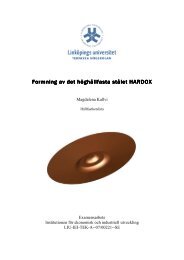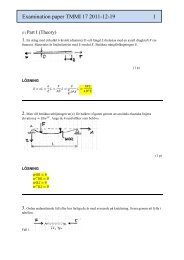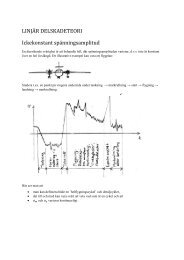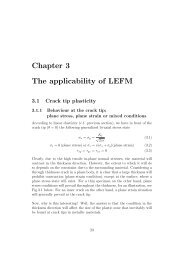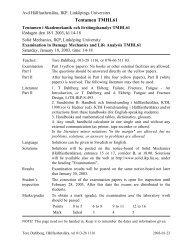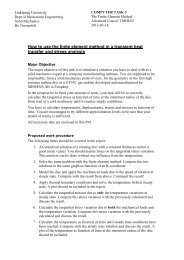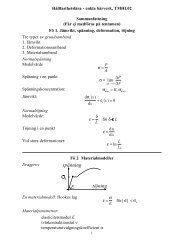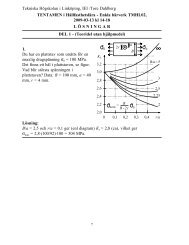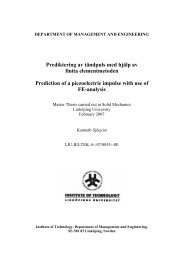Linköpings Universitet, Hållfasthetslära, IEI/IKP Tore Dahlberg ...
Linköpings Universitet, Hållfasthetslära, IEI/IKP Tore Dahlberg ...
Linköpings Universitet, Hållfasthetslära, IEI/IKP Tore Dahlberg ...
You also want an ePaper? Increase the reach of your titles
YUMPU automatically turns print PDFs into web optimized ePapers that Google loves.
Tekniska Högskolan i Linköping, <strong>IEI</strong>/<strong>IKP</strong><br />
<strong>Tore</strong> <strong>Dahlberg</strong><br />
TENTAMEN i Mekaniska svängningar och utmattning, 071016 kl 14-18<br />
EXAMINATION in Mechanical Vibrations and Fatigue<br />
DEL 2 - (Problemdel med hjälpmedel)<br />
5. En massa M hängs upp i tre fjädrar (styvhet<br />
k<br />
k 1 = k, k 2 =2k och k 3 =3k).<br />
1 k 2 k1<br />
k (a) Bestäm egenvinkelfrekvensen för systemet<br />
M<br />
3<br />
k2<br />
om massan och fjädrarna monteras enligt figur<br />
k3<br />
M<br />
(a).<br />
(a)<br />
(b) (b) Vad blir egenvinkelfrekvensen om massan<br />
och fjädrarna monteras enligt figur (b)?<br />
English: 5. A mass M is mounted with three springs (stiffness k 1 = k, k 2 =2k,<br />
and och k 3 =3k).<br />
(a) Determine the (angular) eigenfrequency of the system if the mass and the<br />
springs are mounted as shown in figure (a).<br />
(b) What will the eigenfrequency be if mass and springs are mounted as in<br />
figure (b).<br />
Lösning/Solution:<br />
(a) The equation of motion of the mass is Mẍ =−F 1<br />
− F 2<br />
+ F 3<br />
(a)<br />
where<br />
This gives<br />
which gives<br />
(b) The equation of motion of the mass now becomes Mẍ =−∑F<br />
For the two springs in series one obtains (same force F in the two springs)<br />
Enter this into (b). It gives<br />
and the eigenfrequency becomes<br />
F 1<br />
= k 1<br />
x F 2<br />
= k 2<br />
x and F 3<br />
=−k 3<br />
x<br />
Mẍ +(k 1<br />
+ k 2<br />
+ k 3<br />
)x = 0<br />
ω e<br />
= √⎯⎯⎯⎯<br />
(k 1 + k 2 + k 3 )<br />
= √⎯6 √⎯ k M<br />
M = 2.45 √⎯ k M<br />
x = x 1<br />
+ x 2<br />
= F k 1<br />
+ F k 2<br />
giving k 1k 2<br />
k 1 + k 2<br />
x = F<br />
Mẍ + ⎛ ⎜ ⎝<br />
k 1 k 2<br />
k 1 + k 2<br />
+ k 3<br />
⎞ ⎟⎠ x = 0<br />
ω e<br />
= √⎯⎯⎯⎯⎯<br />
⎛ k 1 k 2<br />
⎜<br />
⎝ (k 1 + k 2 ) + k 3<br />
Thus, the eigenfrequency in case (b) goes down, but not that much, because<br />
the stiffest spring k 3 will dominate the behaviour of the mass in both cases.<br />
⎞<br />
⎟<br />
⎠<br />
(b)<br />
1<br />
M = √⎯ 11<br />
3 √⎯ k M = 1.91 √⎯ k M<br />
10




